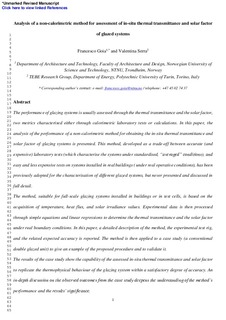| dc.contributor.author | Goia, Francesco | |
| dc.contributor.author | Serra, Valentina | |
| dc.date.accessioned | 2018-07-09T11:35:24Z | |
| dc.date.available | 2018-07-09T11:35:24Z | |
| dc.date.created | 2018-07-03T09:25:25Z | |
| dc.date.issued | 2018 | |
| dc.identifier.citation | Solar Energy. 2018, 166 458-471. | nb_NO |
| dc.identifier.issn | 0038-092X | |
| dc.identifier.uri | http://hdl.handle.net/11250/2504807 | |
| dc.description.abstract | The performance of glazing systems is usually assessed through the thermal transmittance and the solar factor, two metrics characterised either through calorimetric laboratory tests or calculations. In this paper, the analysis of the performance of a non-calorimetric method for obtaining the in-situ thermal transmittance and solar factor of glazing systems is presented. This method, developed as a trade-off between accurate (and expensive) laboratory tests (which characterise the systems under standardised, “averaged” conditions), and easy and less expensive tests on systems installed in real buildings (under real operative conditions), has been previously adopted for the characterisation of different glazed systems, but never presented and discussed in full detail.
The method, suitable for full-scale glazing systems installed in buildings or in test cells, is based on the acquisition of temperature, heat flux, and solar irradiance values. Experimental data are then processed through simple equations and linear regressions to determine the thermal transmittance and the solar factor under real boundary conditions. In this paper, a detailed description of the method, the experimental test rig, and the related expected accuracy is reported. The method is then applied to a case study (a conventional double glazed unit) to give an example of the proposed procedure and to validate it.
The results of the case study show the capability of the assessed in-situ thermal transmittance and solar factor to replicate the thermophysical behaviour of the glazing system within a satisfactory degree of accuracy. An in-depth discussion on the observed outcomes from the case study deepens the understanding of the method’s performance and the results’ significance. | nb_NO |
| dc.language.iso | eng | nb_NO |
| dc.publisher | Elsevier | nb_NO |
| dc.rights | Attribution-NonCommercial-NoDerivatives 4.0 Internasjonal | * |
| dc.rights.uri | http://creativecommons.org/licenses/by-nc-nd/4.0/deed.no | * |
| dc.title | Analysis of a non-calorimetric method for assessment of in-situ thermal transmittance and solar factor of glazed systems | nb_NO |
| dc.type | Journal article | nb_NO |
| dc.type | Peer reviewed | nb_NO |
| dc.description.version | acceptedVersion | nb_NO |
| dc.source.pagenumber | 458-471 | nb_NO |
| dc.source.volume | 166 | nb_NO |
| dc.source.journal | Solar Energy | nb_NO |
| dc.identifier.doi | 10.1016/j.solener.2018.03.058 | |
| dc.identifier.cristin | 1595341 | |
| dc.relation.project | Norges forskningsråd: 255252, 262198 | nb_NO |
| dc.description.localcode | © 2018. This is the authors’ accepted and refereed manuscript to the article. Locked until 5.4.2020 due to copyright restrictions. This manuscript version is made available under the CC-BY-NC-ND 4.0 license http://creativecommons.org/licenses/by-nc-nd/4.0/ | nb_NO |
| cristin.unitcode | 194,61,55,0 | |
| cristin.unitname | Institutt for arkitektur og teknologi | |
| cristin.ispublished | true | |
| cristin.fulltext | postprint | |
| cristin.qualitycode | 2 | |

